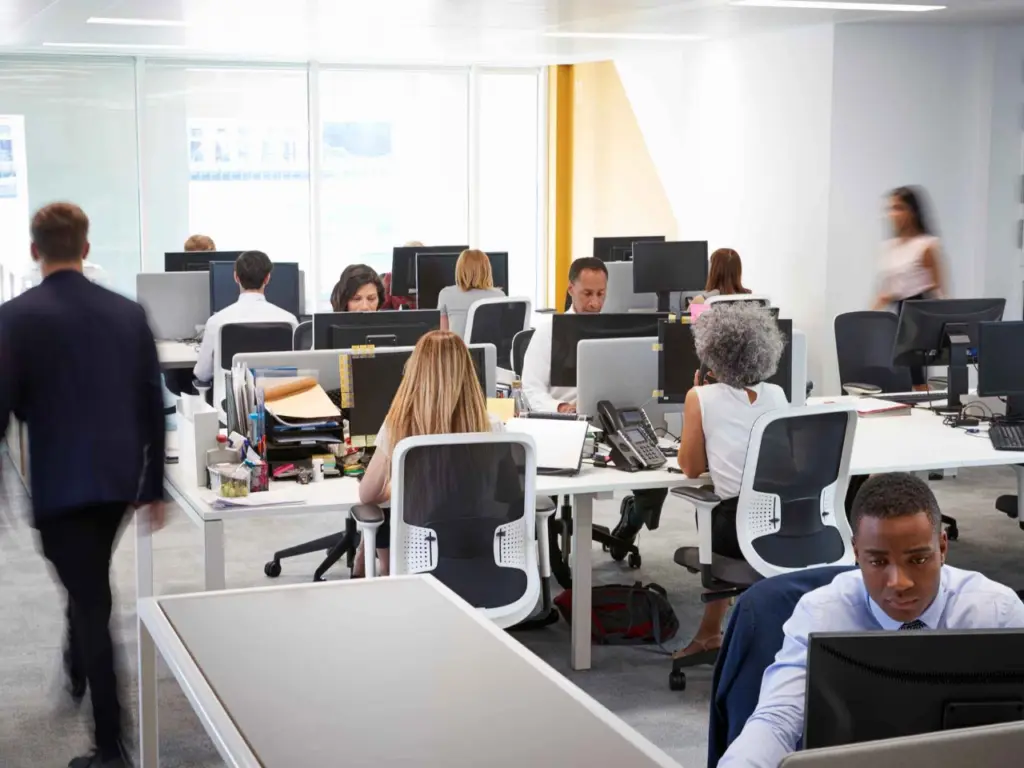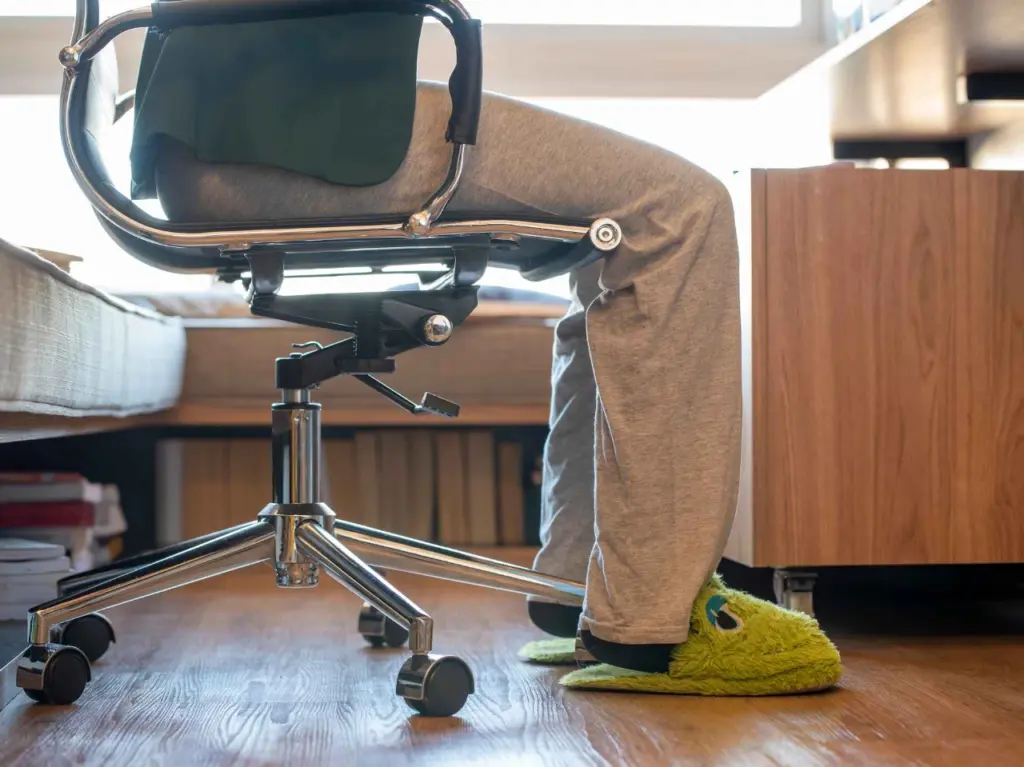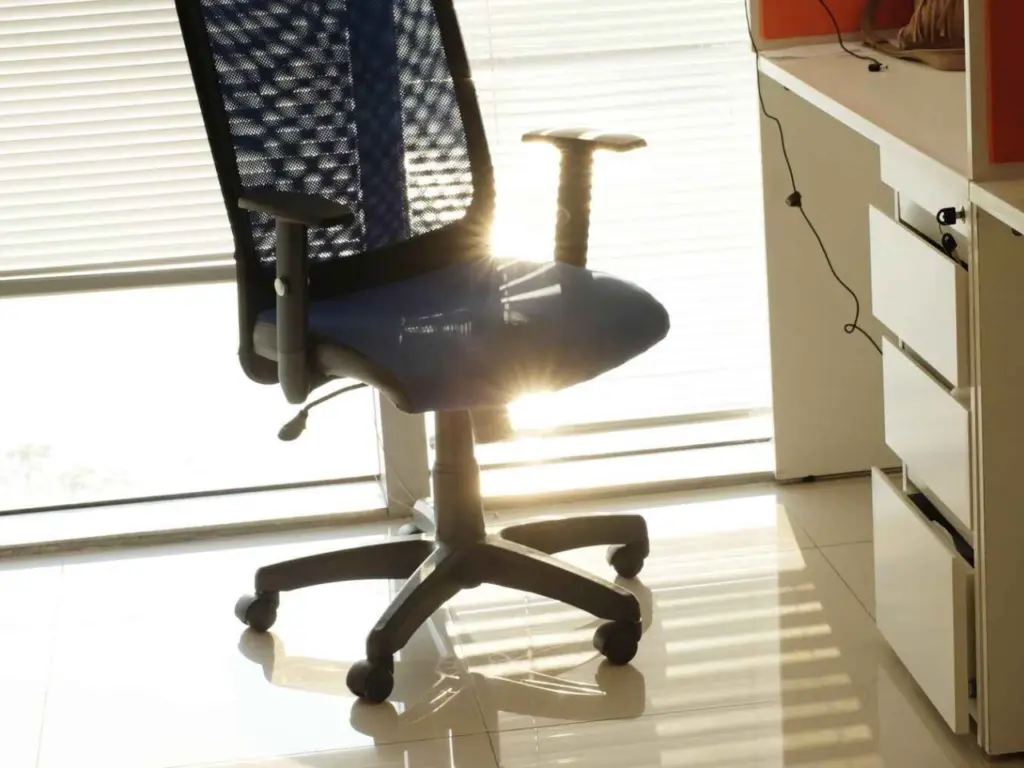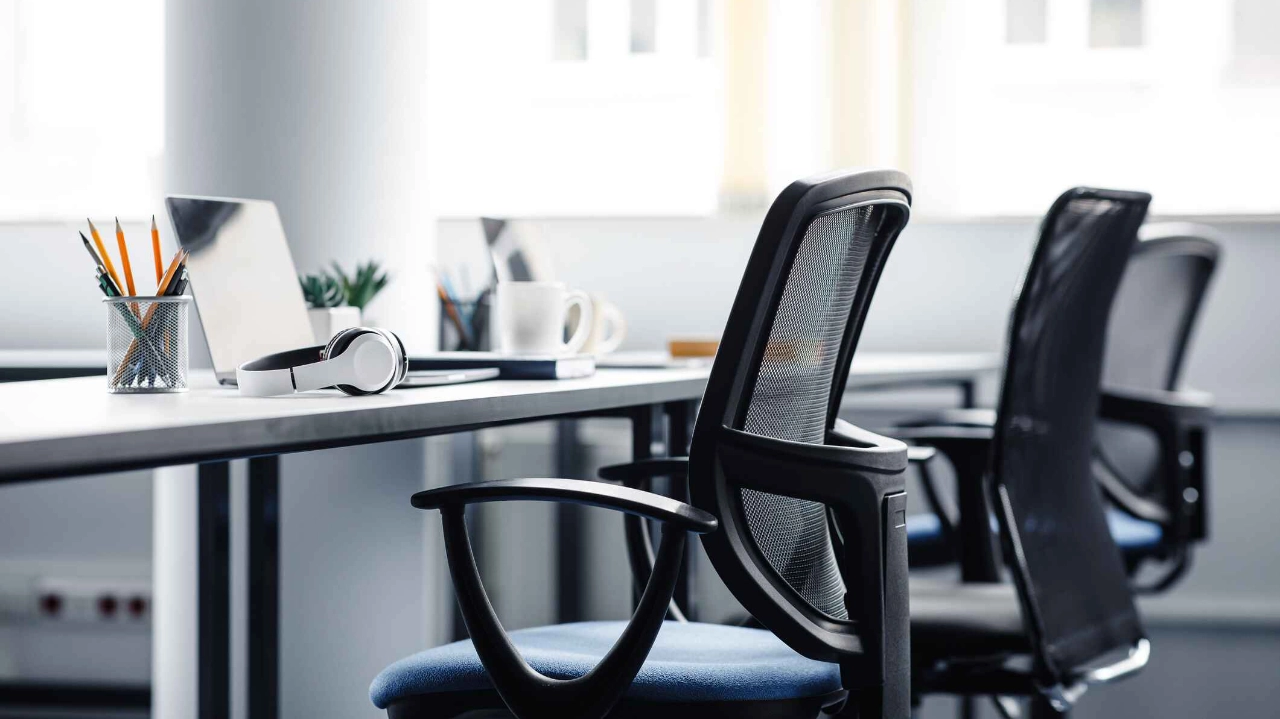When setting up your workspace, choosing the right chair is essential for comfort, productivity, and overall health. Among the various options, task chairs and office chairs are often used interchangeably, but are they really the same?
In this article, we’ll see what makes a task chair different than an office chair, exploring its unique features, ergonomic benefits, and how to pick the best one for your needs.
This guide is a must-read if you’re looking to enhance your office environment with the right seating choice. Read on to learn more.
What is a Task Chair?

A task chair is a variety of chairs specifically designed for use at a desk. Unlike standard office chairs, task chairs are built to support the body during task-oriented work, such as typing or other focused activities.
Task chairs evolved from the operator-style chairs used by early typists and stenographers, with a focus on providing ergonomic support that adapts to the user’s movements.
Task chairs usually feature adjustable settings like height adjustment, seat depth, and backrest tilt, allowing users to customize their seating position for optimal comfort and productivity.
What is an Office Chair?

An office chair, on the other hand, is a more general category that encompasses various types of chairs used in office environments.
Traditional office chairs often feature a swivel base, adjustable height, and basic ergonomic features like a backrest and tilt mechanism.
They are designed to provide comfort for prolonged periods of sitting but may not offer the same level of task-specific support as a task chair.
Office chairs come in a variety of styles, including executive chairs, mesh office chairs, and leather office chairs, catering to different needs and preferences within the office settings.
Office Chair vs Task Chair: What’s the Difference?
While both task chairs and office chairs serve similar purposes, they have distinct differences that can impact their suitability for various tasks.
Task chairs are often more compact and lightweight, with a design that encourages movement and active sitting. They are typically equipped with features that promote better posture, such as adjustable lumbar support and height adjustment, making them ideal for detailed, task-focused work.
In contrast, office chairs tend to be broader and offer more cushioning, designed to provide comfort during longer periods of sitting, such as in meetings or when working at a desk for extended hours.
Office chairs often come with a wider range of adjustability options and additional ergonomic features like armrests and tilt mechanisms, which can enhance comfort and support.
Ergonomics: Why It Matters in Choosing a Chair

Ergonomic design plays a critical role in the structure of both task chairs and office chairs. The ergonomic chair design can significantly affect a user’s posture, reducing the risk of musculoskeletal problems and enhancing productivity.
Task chairs are designed with ergonomics in mind, often featuring adjustable settings that allow users to tailor the chair to their specific body dimensions and task requirements.
This focus on ergonomics ensures that users can maintain a healthy posture, even during extended periods of focused work.
Office chairs also incorporate ergonomic principles, but their design may prioritize overall comfort and aesthetics over task-specific support.
This makes them a versatile choice for a wide range of office activities, from desk work to meetings and collaborative tasks.
Task Chair Features: Is There Really A Difference?

Task chairs are designed with a specific focus on supporting the body during task-oriented work. Key features of task chairs include:
- Adjustable Height and Backrest: Task chairs offer height adjustment and backrest tilt options, allowing users to find the perfect position that supports their spine and promotes good posture.
- Compact Design: Task chairs are generally more compact and lightweight, making them easy to move around and adjust as needed.
- Ergonomic Support: Task chairs often feature ergonomic elements like lumbar support and contoured seating, which help to reduce strain on the back and hips during prolonged periods of focused work.
- Swivel and Mobility: Task chairs typically have 360-degree swivel and smooth-rolling casters, allowing users to move freely and reach different areas of their workspace without strain.
- Armrest Adjustability: Many task chairs come with adjustable armrests that can be moved up, down, or sideways, providing customized support to ease pressure on the shoulders and arms.
- Breathable Materials: Task chairs frequently use breathable mesh or fabric that promotes air circulation, keeping the user cool and comfortable during extended work sessions.
- Seat Depth Adjustment: Some task chairs allow for seat depth adjustment, which helps users position their legs comfortably and maintain proper circulation.
- Tilt Lock and Tension Control: Task chairs often have tilt lock and tension control features that enable users to adjust the chair’s recline resistance, providing personalized comfort and support.
- Durability and Quality Construction: Task chairs are built with high-quality materials and sturdy construction, ensuring long-lasting durability and performance, even with daily use.
- Lumbar Support Adjustability: Good task chairs offer adjustable lumbar support that can be tailored to the user’s lower back curvature, enhancing comfort and reducing the risk of lower back pain.
- Padding and Comfort: Task chairs often include high-density foam padding or other cushioning materials to provide added comfort, especially during long hours of sitting and doing office work.
Office Chair Features: Comfort for the Modern Office

Office chairs are designed to provide comfort and support in a variety of office settings. Common features include:
- Swivel Base and Tilt Mechanism: Office chairs often come with a swivel base and tilt mechanism, allowing users to adjust their seating position and move freely around their workspace.
- Cushioned Seating: Office chairs typically feature cushioned seats and backrests, providing a comfortable seating experience for long hours of desk work.
- Adjustable Armrests: Many office chairs include adjustable armrests, which can help reduce strain on the shoulders and arms during extended periods of use.
- Swivel Base and Tilt Mechanism: Ergonomic office chairs commonly feature a swivel base and tilt mechanism, allowing for flexible movement and adjustments. This is a key difference from regular desk chairs, which may not offer the same level of mobility.
- Cushioned Seating: Cushioned seats and backrests are standard in office chairs, providing enhanced comfort for long periods. In contrast, basic desk chairs might lack this level of cushioning.
- Adjustable Armrests: Office chairs often include adjustable armrests to reduce strain on the shoulders and arms, unlike task chairs where armrests may be fixed and less versatile.
- Height Adjustment: Office chairs come with height adjustment features to align with desk height, supporting ergonomic alignment. This feature is less commonly adjustable in standard desk chairs.
- Lumbar Support: Built-in lumbar support in office chairs helps maintain proper spinal alignment, reducing lower back pain. Task chairs might not offer this level of support.
- Seat Depth Adjustment: Office chairs allow for seat depth adjustment to accommodate different leg lengths, providing better back support compared to basic desk chairs.
- Backrest Recline: The ability to recline the backrest is a common feature in office chairs, offering customizable support. This feature is often absent in standard task chairs.
- Breathable Fabric: Many office chairs use breathable materials, such as mesh, to keep users cool. Standard desk chairs may not offer the same breathability.
- 5-Point Base with Casters: Office chairs usually have a 5-point base with casters for stability and ease of movement. This is a functional advantage over more rigid or less stable task chairs.
- Headrest: Many office chairs come with an adjustable headrest, providing neck support. This feature is typically not found in basic desk chairs.
When to Choose a Task Chair Over an Office Chair
Choosing between a task or an office chair at work depends on the unique needs of your workspace and the type of work you do. Task chairs are often the best choice for:
- Focused, Task-Oriented Work: Task chairs coax the body into an upright, task-ready position, making them ideal for activities like typing, drafting, or other focused tasks.
- Smaller Workspaces: Due to their compact design, task chairs are perfect for smaller office spaces or home offices where space is at a premium.
- Focused, Task-Oriented Work: They promote an upright, task-ready position, making them ideal for activities like typing or drafting. This ergonomic design boosts focus and productivity.
- Smaller Workspaces: With their compact and streamlined design, task chairs are perfect for smaller offices or home workspaces where space is limited.
- Frequent Movement: Task chairs offer mobility with features like adjustable height, swivel functions, and smooth-rolling casters, making it easier to move between tasks or areas without needing to adjust the chair frequently.
- Temporary or Short-Term Use: They are often more budget-friendly and designed for lighter use, making them an ideal choice for temporary work environments or less intensive tasks.
- Dynamic Work Environments: For settings where you need to switch between different tasks or postures, task chairs provide versatility with adjustable features such as lumbar support and armrests.
Ergonomic Features to Look For in Chairs

When selecting a chair for your office space, consider the following ergonomic features:
- Adjustable Lumbar Support: Helps maintain the natural curve of the spine and reduces lower back strain.
- Height Adjustment and Tilt Mechanisms: This allows you to customize the chair’s position for optimal comfort and support.
- Adjustable Armrests: Reduce strain on the shoulders and arms, providing additional support during long periods of sitting.
Final Thoughts
While task chairs and office chairs may seem similar, they serve distinct purposes tailored to different needs. Task chairs are specifically designed to support focused, task-oriented work with features that enhance ergonomics, mobility, and adaptability.
They are excellent for smaller spaces and tasks requiring precision and movement. On the other hand, office chairs encompass a broader range of designs, often prioritizing overall comfort and style suitable for diverse office settings and prolonged use.
Understanding these differences helps in selecting the right chair to enhance both comfort and productivity in your workspace.
Whether you need a task chair for a compact workspace or an office chair for extended periods of sitting, considering your specific needs and ergonomic requirements will ensure a more comfortable and productive work setting.
Frequently Asked Questions
What are the key ergonomic benefits of using a task chair?
An ergonomic task chair provides critical lower back support, reducing strain and promoting proper spinal alignment, which is essential for the average office worker who works long hours. Here’s a detailed breakdown:
Lumbar Support: An ergonomic task chair provides critical lower back support, reducing strain and promoting proper spinal alignment, which is essential for those who work long hours.
Adjustable Features: These chairs often come with multiple adjustable features, such as height, armrests, and seat depth, allowing users to find the perfect chair to suit their specific needs.
Tilt Mechanism: Many modern task chairs feature a tilt mechanism, enabling users to recline and shift angles, which helps relieve pressure and maintain a healthy posture during extended periods of sitting.
Seat Padding: Comfortable chairs are equipped with cushioned seats that prevent discomfort and ensure support, making them ideal for typists and those who work long hours.
An ergonomic task chair is crucial for enhancing comfort and productivity, making it a key piece of furniture in any workspace where work can be a critical component of daily routines.
How does the design of a task chair impact productivity in an office environment?
The design of a task chair can greatly affect productivity by enhancing comfort and functionality within an office setting. Here’s how:
Ease of Movement: Functional chairs with swivels and casters make it easy to move around and access different parts of the workspace, which is essential for efficient work.
Adjustability: The choice between a task chair and a standard office chair often comes down to the chair’s adjustability. A task chair allows users to adjust their seating position, improving comfort and focus.
Support Features: Ergonomic task chairs with features that make the chair supportive, such as lumbar support and adjustable armrests, help reduce physical strain and allow users to work comfortably for longer periods.
Comfort Levels: Opting for a comfortable chair with adequate padding and adjustability can significantly reduce physical fatigue and enhance overall productivity.
Choosing the right chair can make a significant difference in maintaining high levels of productivity and comfort.
What materials are commonly used in task chairs, and how do they affect comfort and durability?
Task chairs are made from various materials, each influencing comfort and durability in different ways. Here’s an overview:
Leather Chairs: Leather task chairs offer a classic and sophisticated look, providing durability and comfort, though they may require regular maintenance to stay in top condition.
Mesh Task Chairs: Known for their breathability, mesh task chairs are ideal for ventilation, which helps keep users cool and comfortable during long hours of work.
Fabric Chairs: Fabric chairs provide a soft, comfortable seating experience but can vary in breathability and ease of cleaning, impacting long-term comfort.
Foam Padding: Often used in seat cushions, foam padding enhances comfort by providing additional support and cushioning, making it ideal for those who work long hours. It is one of the chairs available that offers significant comfort benefits.
The choice of materials affects both the comfort and lifespan of a task chair, influencing how well it performs in different work environments.
How do you choose the perfect task chair for your office needs?
Finding the perfect chair involves evaluating various factors to meet your specific office requirements. Here’s how to make a smart choice:
Adjustability: When deciding between a task chair or an office chair, consider how adjustable the chair is. Features like height, lumbar support, and armrests should be tailored to your ergonomic needs.
Comfort: Look for a comfortable chair that offers good padding and ergonomic design. Modern task chairs are designed to reduce strain and enhance comfort during long work sessions.
Size and Fit: Ensure the chair fits your body size and office dimensions. Different chairs are available to accommodate various sizes and workspace configurations, helping to make your office both functional and comfortable.
Durability: Opt for a task chair made from high-quality materials that can endure regular use and maintain its functionality over time.
Choosing the right task chair is crucial for ensuring both comfort and productivity in your workspace.
What are the differences between task chairs and other types of office chairs?
Understanding the differences between task chairs and other office chairs can help you select the best option for your needs. Here’s a comparison:
Functionality: Task chairs are designed for specific tasks that require frequent adjustments and movement, while an office chair or task chair may prioritize general comfort or aesthetics.
Ergonomic Features: Task chairs often come with advanced ergonomic features like adjustable lumbar support and tilt mechanisms, which may not be present in all office chairs.
Design and Aesthetics: Modern task chairs tend to have a more functional design focused on ergonomic benefits, whereas traditional office chairs might emphasize style and appearance. Understanding the differences between office chairs can help you select the best option for your needs.
Specialized Chairs: In certain environments, specialized chairs like leather chairs or mesh task chairs are preferred for their unique features and suitability for different tasks.
Knowing these differences helps in making an informed choice between task chairs and other office chair options to meet your specific needs.

